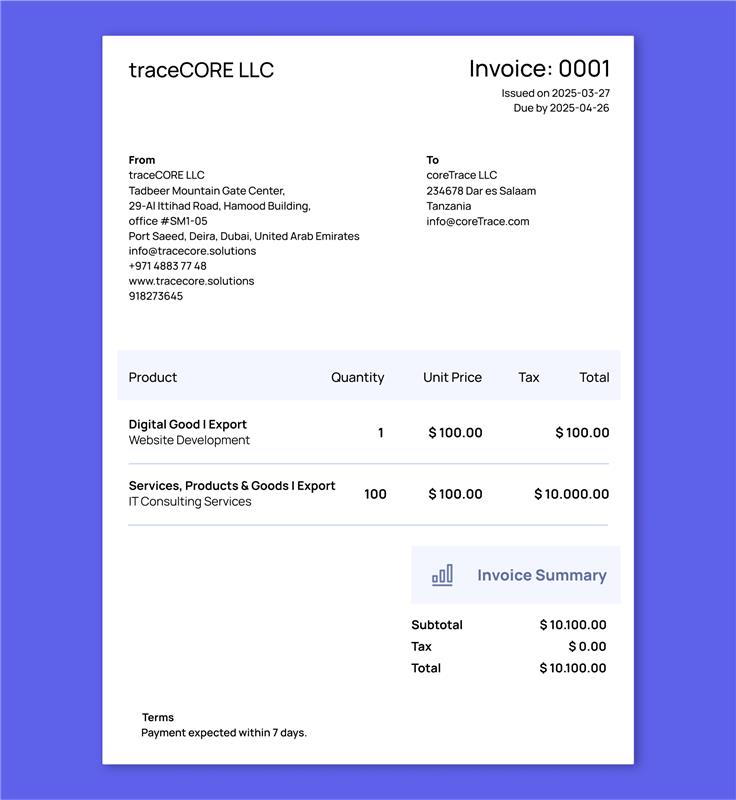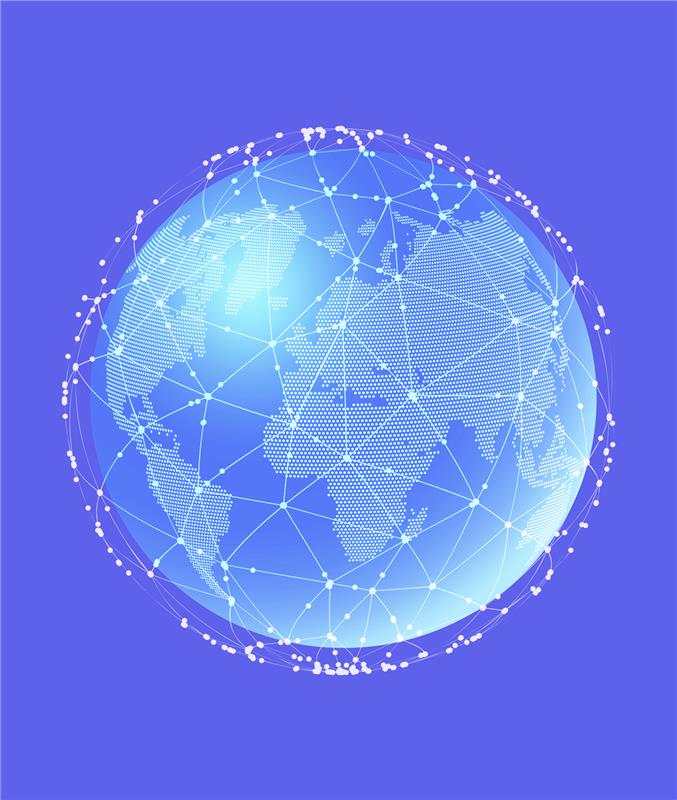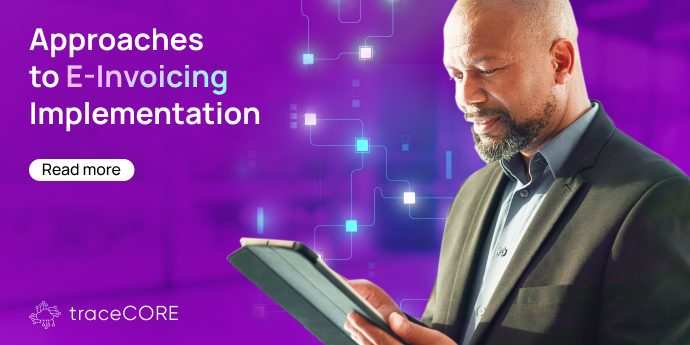.jpg)
To respond to the evolving digital landscape, governments are innovating to combat fraud and streamline their economies. One powerful tool is mandatory e-invoicing.
The e-invoicing initiative is a crucial step toward implementing continuous transaction controls. As government agencies closely monitor e-invoices from start to finish, they can leverage CTC (Continuous Transaction Control) for real-time tax and data reporting.
What Is a Regular Invoice?
An invoice is a legal document that outlines the products or services provided to a customer along with their costs.
It is commonly used for business-to-business transactions and is required by law if both parties are registered for VAT. While private individuals may sometimes request an invoice, in most cases, it is not mandatory for business-to-consumer transactions.

An invoice contains several important details about a transaction.
These typically include:
- A unique identifier for tracking purposes.
- When the invoice was issued.
- The seller’s details, like their name, address, and contact info.
- The buyer’s details, similar to vendor info.
- Detailed list of items or services provided.
- Total cost before taxes, discounts, or fees.
- Any applicable charges itemized separately.
- The final amount the buyer must pay after adjustments.
- Agreed-upon due date and payment methods.
These components vary based on business type, transaction complexity, and local regulations, but they are more or less consistent across different invoices.
Why Do We Need Invoices?
Legal Proof of Transaction
Invoices act as official records that confirm the details of a sale or service, protecting both buyer and seller in case of disputes.
Cash Flow Management
By outlining due dates and payment terms, invoices help businesses monitor and manage cash flow effectively
Tax Reporting
Invoices are essential for calculating and documenting taxes, ensuring businesses comply with tax regulations and avoid penalties.
Financial Organization
Invoices help businesses track income, expenses, and payments, making financial record-keeping more streamlined and organized.
Professional Image
Issuing invoices demonstrates professionalism, promoting trust and credibility with clients, which can lead to long-term business relationships.
Payment Tracking
Invoices clearly specify amounts owed and payment deadlines, helping businesses track outstanding payments and minimize late payments.
Understanding E-Invoices: Their Lifecycle and Key Features
E-invoicing, a document exchanged between suppliers and buyers, revolutionizes the traditional invoicing process by digitizing it entirely.
Data is created, sent, received, processed, and stored digitally using specific formats like XML, JSON, Peppol BIS, and EDIFACT, which ensures compatibility with ERP systems.
Terms like digital invoice or e-bill are sometimes used interchangeably with e-invoice, but they may not always meet the same criteria.
Real-Time
E-invoices are sent and received instantly, allowing for faster processing and reducing delays compared to traditional paper invoicing.
Syncs with Accounting
Can be integrated with accounting software, ensuring automatic updates and seamless synchronization between invoicing and financial records.
Fully Electronic
E-invoices are fully digital, there's no need for paper, printing, or physical storage, making the process more efficient and environmentally friendly.
Automated Workflow
E-invoicing systems automate many parts of the invoicing process, including generation, sending, and tracking, which reduces manual labor and errors.
The E-Invoicing Process
Customer invoicing (outgoing invoices, accounts receivable):
- An e-invoice is generated by a user within an ERP system or e-invoicing platform to charge customers for products or services.
- It is transmitted to the customer using integrated solutions to maintain data accuracy.
- Automated validation ensures that the invoice complies with rules and standards before delivery.
- The validated e-invoice is dispatched to the customer in the format they prefer.
Supplier invoicing (incoming invoices, accounts payable):
- The electronic invoice is sent from a supplier and added directly to the buyer’s financial system.
- The invoice data is processed in a structured format for review and validation.
- Automated review verifies the invoice’s compliance with regulations.
- The checked invoice information is automatically recorded in the financial system for easier payments and managing what is owed.
Types of Invoicing: B2B, B2C, B2G.
Whether digital or traditional, there are three main categories for invoicing.
B2B, or Business-to-Business, Invoicing
involves businesses exchanging invoices with each other.
B2C, or Business-to-Consumer, Invoicing
is when businesses send invoices to individual customers.
B2G, or Business-to-Government, Invoicing
refers to businesses sending invoices to government agencies for goods and services.
Governments are pushing for B2G e-invoicing to save costs (up to 80%) and encourage private businesses to adopt e-invoicing. This shift is expected to influence B2B invoicing, as more companies will likely adopt e-invoicing to meet supplier demands in the future.
11.jpg)
The Purpose and Application of VAT Invoices
A VAT invoice is a crucial document used in countries where value-added tax is applied to sales. It includes the VAT charged on goods and services sold and is necessary when both parties are VAT-registered. This invoice outlines all details of a taxable supply, which determines VAT liability.
Additionally, VAT-registered customers can reclaim the VAT charged to them using this invoice. In some cases, a tax invoice and a receipt are merged into one document called a simplified invoice, usually for small purchases. However, each country has its own rules and limits for when simplified invoices can be used.
Another type of invoice is the modified VAT invoice, which displays the price of each item along with the VAT and the total cost, including VAT. This should only be used for sales over a certain threshold and if the customer agrees to it. If not, the business will need to issue a regular VAT invoice.
Invoice vs. Check: How They Differ
Invoices or e-invoices are often confused with bills (requests for payment), statements (summaries of transactions over a period), and receipts (acknowledgements of payment received).
The closest out of these is a bill. The main difference between a bill and an invoice is the timing of the transaction process. A bill is sent before payment, while an invoice is sent after the sale, and it outlines what was bought and the amount owed.
The Advantages of E-Invoicing

- Additional revenue sources for the budget: Leads to increased tax revenues for the government.
- Prevention of unfair competition: Helps maintain a level playing field among businesses thanks to tax compliance.
- Transparent business environment: Promotes transparency in business transactions, which makes it easier to monitor and regulate economic activities.
- Reduction of shadow economy: By digitizing invoicing processes, e-invoicing helps in minimizing underground economic activities.
- Reduced tax administration costs: The automation of invoicing and tax processes helps in cutting down administrative expenses.
- Quality data for decision-making: Provides tax authorities with accurate and real-time data, which enables informed decision-making and policy formulation.
.svg)
- Reduction of taxpayer administrative burden: Streamlines the invoicing and tax reporting process for businesses.
- Compliance: Helps businesses meet government rules and, thus, avoid fines and reputation damage.
- Simplified VAT administration: Businesses no longer need to file separate VAT declarations, as tax authorities handle the entire process.
- Environmental efficiency: Promotes environmental sustainability by cutting down on paper use and eliminating CO2 emissions from shipping and transportation.
- Analytics and forecasting: Provides digital, validated, and transparent data to extract deeper insights into spending patterns.
- Enhanced business relationships: Fosters smoother, reliable, and trustworthy operations for all parties involved.
E-Invoicing Around the Globe
North America
E-invoicing in North America. Canada is exploring ways to enhance digitalization levels for businesses. However, the US lacks government initiatives due to cultural and federal organization reasons.
Latin America
Many countries in Latin America have implemented CTC models, making e-invoicing mandatory for the majority of taxpayers. These countries share a common approach in their continuous transaction control systems, as they all follow the Clearance model.
Europe
Many EU countries have adopted B2G e-invoicing mandates and are transitioning to CTC. Some countries like Italy, France, and Germany have already implemented CTC, while others like Belgium and Spain are planning to do so. The EU Commission has proposed the VAT in the Digital Age (ViDA) initiative to harmonize VAT collection within the Union.
Asia-Pacific
When it comes to the APAC region, India and China prefer clearance-based models with government approval, while others like Australia and Japan focus on Peppol-centric interoperability. Malaysia plans to combine a hybrid centralized CTC model with the Peppol network.
Middle East
Leading the way in the Middle East region, Saudi Arabia began the implementation of nationwide e-invoicing in 2021. The government of the United Arab Emirates is preparing for the widespread introduction of B2B e-invoicing by 2026.
Africa
African nations primarily use hardware-based fiscalization models to combat the indirect tax gap. Egypt has introduced CTC regulations, with more countries expected to follow suit in the coming years.



